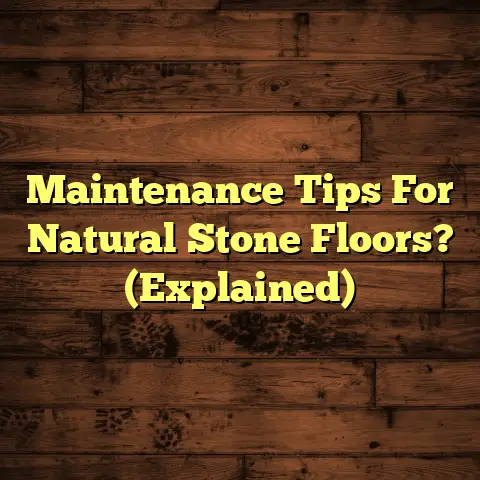Home Gym Floor Mats? (3 Key Selection Tips!)
I’ve seen countless home gyms, from basic setups to full-blown fitness paradises.
One thing I’ve learned is that flooring can make or break your workout experience.
With the recent global health events, more and more people are opting for the convenience and safety of home gyms.
It’s a fantastic trend!
But before you start pumping iron or perfecting your yoga poses, let’s talk about something crucial: flooring.
Your floor impacts everything – safety, comfort, and even your performance.
And these days, we’re not just thinking about performance; we’re thinking about the planet.
That’s why I’m so passionate about eco-friendly flooring options.
They’re not just good for your body; they’re good for the environment, too.
Eco-friendly mats can contribute to healthier indoor air quality and give you a safe workout space.
In this article, I’m going to share my top three selection tips for choosing the right home gym floor mats, with a special focus on sustainable options.
Let’s dive in and create a workout space that’s both effective and eco-conscious!
Section 1: Understanding Floor Mats and
Their Importance
So, what exactly are gym floor mats?
Simply put, they’re protective coverings designed to go between your equipment (and you!) and your existing floor.
They come in various materials, each with its own pros and cons.
You’ve probably seen the usual suspects: rubber, foam (like EVA foam), and sometimes even vinyl.
But why bother with floor mats at all?
Well, the benefits are numerous:
-
Impact Absorption: This is huge, especially if you’re into weightlifting or high-impact cardio. Mats cushion your joints and reduce the risk of injuries.
-
Noise Reduction: Trust me, your downstairs neighbors will thank you. Mats absorb sound, minimizing the clanging of weights and the thud of jumping jacks.
-
Floor and Equipment Protection: Dropped a dumbbell? No problem (hopefully!). Mats protect your floor from dents and scratches and can also extend the life of your equipment by reducing vibration.
-
Slip Resistance: Safety first! Gym mats provide a non-slip surface, even when things get sweaty.
Think about it: a slippery floor plus heavy weights is a recipe for disaster.
According to the National Safety Council, falls are a leading cause of injury in the home.
Gym mats help prevent those accidents.
Beyond these practical benefits, there’s also the comfort factor.
Working out on a hard, unforgiving surface is no fun.
Mats provide a more comfortable and supportive base for your exercises.
Now, let’s talk about eco-friendliness.
Why is it so important?
Well, traditional flooring materials like PVC can contain harmful chemicals and release VOCs (Volatile Organic Compounds) into the air.
These VOCs can contribute to indoor air pollution and potentially cause health problems.
Eco-friendly materials, on the other hand, are made from sustainable resources and are free from harmful chemicals.
They’re a healthier choice for you and a more responsible choice for the planet.
Choosing eco-friendly mats is a win-win!
Section 2: Key Selection Tip 1 –
Material Matters
Alright, let’s get into the nitty-gritty of materials.
This is where things can get a little overwhelming, but I’m here to break it down for you.
As I mentioned earlier, traditional gym floor mats are often made from materials like PVC (polyvinyl chloride), which, honestly, I try to steer my clients away from.
PVC can release harmful VOCs, especially when it’s new.
So, what are the eco-friendly alternatives?
Here are a few of my favorites:
-
Natural Rubber: This is a fantastic option. Natural rubber is made from the sap of rubber trees, a renewable resource. It’s incredibly durable, provides excellent cushioning, and has a naturally grippy surface.
-
Pros: Excellent durability, high impact absorption, naturally slip-resistant.
-
Cons: Can have a rubbery odor initially, may be slightly more expensive than synthetic options.
-
-
Cork: Yes, the same stuff used in wine stoppers! Cork is harvested from the bark of cork oak trees, which regenerates over time. It’s naturally antimicrobial, provides good cushioning, and has a unique, natural look.
-
Pros: Sustainable, antimicrobial, comfortable underfoot.
-
Cons: Not as durable as rubber for heavy weightlifting, can be more susceptible to damage from sharp objects.
-
-
Recycled Materials: This is a broad category that includes mats made from recycled rubber tires, recycled foam, and even recycled plastic. These mats are a great way to reduce waste and give new life to materials that would otherwise end up in a landfill.
-
Pros: Environmentally friendly, often more affordable than virgin materials.
-
Cons: Durability can vary depending on the quality of the recycled materials.
-
Why are these materials superior?
Let’s talk about VOCs again.
Many traditional flooring materials, including PVC, contain phthalates and other chemicals that can off-gas into your home.
Eco-friendly materials, on the other hand, are typically low-VOC or VOC-free.
This means they won’t release harmful chemicals into the air, creating a healthier indoor environment.
According to the EPA, indoor air can be more polluted than outdoor air.
Choosing low-VOC flooring is a simple way to improve your indoor air quality.
In terms of durability, natural rubber is a clear winner.
It can withstand heavy use and is resistant to tearing and abrasion.
Cork is a bit less durable but still provides good performance for most home gym activities.
Recycled materials can vary in durability, so it’s important to choose a reputable brand that uses high-quality recycled content.
Maintenance is another key consideration.
Most eco-friendly gym mats are easy to clean with mild soap and water.
Avoid harsh chemicals, as they can damage the material.
For rubber mats, I recommend occasionally wiping them down with a damp cloth to remove any sweat or dirt.
Cork mats should be sealed with a natural sealant to protect them from moisture.
When it comes to overall performance, eco-friendly materials hold their own against traditional options.
In many cases, they actually outperform them.
For example, natural rubber provides superior cushioning and slip resistance compared to PVC.
And cork offers a unique combination of comfort and antimicrobial properties.
I always tell my clients: don’t just take my word for it.
Look for certifications like Greenguard Gold, which ensures that a product has been tested for low chemical emissions.
These certifications provide peace of mind and help you make informed choices.
Here’s a quick comparison table:
| Material | Durability | VOCs | Cushioning |
|---|---|---|---|
| Natural Rubber | Excellent | Low | Excellent |
| Cork | Good | Low | Good |
| Recycled Rubber | Good | Low | Good |
| PVC (Traditional) | Fair | High | Fair |
Section 3: Key Selection Tip 2 –
Thickness and Density
Okay, so you’ve decided on an eco-friendly material. Great!
Now, let’s talk about thickness and density.
These two factors play a huge role in the performance, comfort, and safety of your gym mats.
Why do they matter?
Thickness refers to the height of the mat, while density refers to how tightly packed the material is.
A thicker, denser mat will generally provide more cushioning and support.
But the ideal thickness and density will depend on the type of workouts you plan to do.
Let’s break it down by activity:
-
Weightlifting: For heavy weightlifting, you’ll want a thick, dense mat that can absorb the impact of dropped weights. I recommend a thickness of at least 3/8 inch (10mm) and a density of 60-80 kg/m3. This will protect your floor and reduce the risk of injury.
-
Yoga and Pilates: For yoga and Pilates, you don’t need as much cushioning. A thinner mat with a thickness of around 1/4 inch (6mm) will provide enough support while still allowing you to feel grounded. Density is less critical for these activities.
-
Cardio: For high-impact cardio exercises like jumping jacks and burpees, you’ll want a mat that provides good cushioning to protect your joints. A thickness of 1/2 inch (12mm) or more is ideal. Look for a mat with a medium density to provide a balance of cushioning and support.
-
General Fitness: If you plan to do a variety of activities, a mat with a thickness of 3/8 inch (10mm) is a good all-around choice.
How do eco-friendly mats stack up in terms of thickness and density?
Well, it depends on the material.
Natural rubber mats are typically available in a wide range of thicknesses and densities, making them suitable for a variety of activities.
Cork mats tend to be thinner and less dense than rubber mats, but they still provide good cushioning for yoga and Pilates.
Recycled rubber mats can vary in thickness and density depending on the source of the recycled material.
When choosing a mat, pay attention to the manufacturer’s specifications.
They should provide information on the thickness, density, and intended use of the mat.
Don’t be afraid to ask questions if you’re unsure.
I always tell my clients to consider their individual needs and preferences.
If you have sensitive joints, you may want to opt for a thicker, more cushioned mat.
If you prefer a firmer surface, a thinner mat may be a better choice.
It’s also important to consider the stability of the mat.
A mat that’s too thick or too soft can be unstable, making it difficult to balance.
Look for a mat that provides a good balance of cushioning and support.
Here’s a quick guide to choosing the right thickness:
| Activity | Recommended Thickness |
|---|---|
| Weightlifting | 3/8 inch (10mm) + |
| Yoga/Pilates | 1/4 inch (6mm) |
| Cardio | 1/2 inch (12mm) + |
| General Fitness | 3/8 inch (10mm) |
Section 4: Key Selection Tip 3 –
Size and Coverage
Alright, you’ve got the material and the thickness sorted out.
Now, let’s talk about size and coverage.
This is where you need to think about the layout of your home gym and the types of workouts you’ll be doing.
Why is size and coverage important?
Well, you want to make sure you have enough space to move around safely and comfortably.
You also want to protect your floor from damage.
The first step is to measure the space where you plan to set up your home gym.
Take accurate measurements of the length and width of the area.
Consider the types of equipment you’ll be using.
Will you have a treadmill, a weight bench, or a squat rack?
Make sure you have enough space around each piece of equipment to move freely.
Once you have your measurements, you can start thinking about the best arrangement for your gym mats.
There are several options to choose from:
-
Single Mat: This is a good option for small spaces or for activities like yoga and Pilates.
-
Interlocking Mats: These mats are like puzzle pieces that fit together to create a larger surface. They’re a great option for creating a custom-sized workout area.
-
Roll-Out Mats: These mats come in long rolls that you can unroll to cover a large area. They’re a good option for covering an entire room.
Eco-friendly options are often available in all of these formats.
Interlocking mats made from recycled rubber are particularly popular.
They’re easy to install and can be customized to fit any space.
When choosing the size and configuration of your mats, consider the following:
-
Safety: Make sure you have enough space to move around safely without bumping into walls or equipment.
-
Functionality: Choose a configuration that works well for the types of workouts you plan to do.
-
Aesthetics: Choose a color and style that you like and that complements the rest of your home decor.
Here are a few popular sizes and configurations for different types of home gyms:
-
Small Home Gym (Yoga/Pilates): A single mat (24″ x 68″) or a set of interlocking mats (4′ x 6′).
-
Medium Home Gym (General Fitness): A set of interlocking mats (6′ x 8′) or a roll-out mat (6′ x 10′).
-
Large Home Gym (Weightlifting): A large roll-out mat (8′ x 12′) or a custom configuration of interlocking mats.
Remember, you can always add more mats later if you need to.
It’s better to start with a smaller area and expand as needed.
Conclusion
So, there you have it: my top three selection tips for choosing the right home gym floor mats.
Let’s recap:
-
Material Matters: Choose eco-friendly materials like natural rubber, cork, or recycled materials to protect your health and the environment.
-
Thickness and Density: Select the right thickness and density based on the types of workouts you plan to do.
-
Size and Coverage: Measure your space and choose a size and configuration that provides enough room to move around safely and comfortably.
Investing in quality, eco-friendly mats is a smart move for both your fitness and the environment.
You’ll create a safer, more comfortable, and more sustainable workout space.
When choosing mats, think about your specific workout needs and preferences.
Do you need a thick, cushioned mat for weightlifting?
Or a thinner, more stable mat for yoga?
Prioritize sustainability in your fitness journey.
Choose eco-friendly options whenever possible.
And don’t be afraid to ask questions and do your research.
Ready to create a healthier, more sustainable workout environment?
Explore eco-friendly options for your home gym today!
Your body and the planet will thank you.





